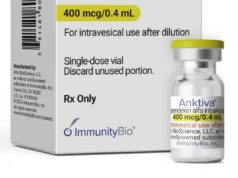In an interview, TriNet’s Vice President of Life Sciences, Maria Abouseif, talked about the role Professional Employer Organizations play in helping life science companies navigate the COVID-19 public health crisis.

Maria Abouseif, Vice P of TriNet
What’s the value of a Professional Employer Organization (PEO) for life science companies?
Most life science companies develop relationships to augment internal resources and capabilities. For instance, small to mid-sized pharma and biotech companies tend to outsource
clinical trials. In many cases, it is less expensive and more efficient to outsource those functions to external organizations, than it is to create an end-to-end, in-house set up and hire the necessary research staff.
A PEO acts in a similar fashion. Small to medium sized biotech and medical device companies choose to team up with an external organization to augment their HR function and capabilities. This allows them to attract top talent, help maintain HR compliance across multiple states and leverage technology to improve performance and drive smarter organizational decisions – all while increasing efficiencies and lowering the burn rate for the organization.
As an example, a PE-backed medical device company we work with wanted to expand across the country, but its HR team was small. They were struggling to keep up with changing regulations and offering health insurance in multiple states. TriNet’s platform and services allowed their team to provide access to premium benefits across the country and spend less time navigating each state’s payroll tax and regulatory requirements. They were able to create significant efficiencies within the organization, which in turn extended their cash runway.
What is the value of a PEO in attracting and hiring talent within the life sciences industry? What challenges do startup companies face in the current environment?
The life science industry is poised for growth and they need to acquire and retain talent in 2020 and beyond. Startups are often competing with big pharma and academia for top talent, so many of the innovative companies we work with want to go beyond competitive salary and stock options to attract top candidates and retain their employees. A Professional Employer Organization (PEO) can help a startup offer access to top tier benefit options to their employees, which may not be accessible to them on their own. These options include access to large group health insurance with multiple plan offerings, telemedicine, 401(k) plans, employee-paid voluntary insurance, and pet insurance which can all be important factors people consider when deciding to work for a company. A PEO can level the playing field for smaller to medium size companies to help them with acquiring the best talent, particularly hiring and onboarding remotely in the current environment.
One of the companies we work with is a medical device business developing lifesaving products. Initially they handled HR internally. Despite their small size (approximately 20 – 30 employees), the company wanted to offer a “gold standard” to attract top talent and support their next phase of growth. They teamed up with TriNet to offer access to a range of premium-level benefits to meet the needs of their employees and compete with larger life sciences companies. In turn, they were able to attract top talent to double their workforce in less than 2 years across multiple states.
What’s the role of technology in building a remote workforce and sustaining the company culture?
Technology plays an important role in continuing to build a strong company culture. It helps bring teams together to collaborate, communicate and work. It also allows business leaders to have a 360-degree view into their business and their employee life cycle. From recruiting, onboarding, payroll, PTO and time tracking to learning and development, performance management and expense management, the most common HR tools can be accessed from one platform.
In the throes of the COVID-19 pandemic, most business leaders’ top priority is the health and safety of their employees, families, and communities. With access to the right tools and resources, companies have shifted to a remote work environment where possible. In fact, according to a recent poll by TriNet and The Harris Poll, 82% of SMBs have taken actions to enhance employee wellbeing. Respondents felt that the most effective of these actions was allowing for the flexibility to balance the new work/home life conditions.
How has TriNet helped their Life Science customers keep up with the legislative updates?
Life Science startups with teams across multiple locations and states must navigate complex regulations to maintain compliance. One of our life science clients had a team of 200+ exempt and non-exempt employees located in nine different states. To add to the complexity, they previously used a multi-vendor approach for HR functions. It didn’t take long for their CEO to realize she needed TriNet’s HR expertise and solutions for her to grow the business with confidence. Keeping up with HR regulations can be a daunting task for a smaller HR team. By teaming up with TriNet, their internal HR team pivoted to execute on an in-house recruiting strategy instead of managing the time-consuming payroll and benefits administration tasks.
Other examples would be in the area of R&D tax remittance. One of the biotech companies who has been in the business for several years was still doing a ton of R&D work pre-revenue but wasn’t taking advantage of any R&D tax credits. We were able to work with their CPA to help them claim the R&D payroll tax credit. We also follow IRS guidance on processing other tax credits and deferrals such as CARES Act Social Security Deferral, FFCRA sick leave payroll tax credits, and CARES Act employee retention credits, which are very important to clients, especially during COVID-19. This helps offset certain costs associated with payroll.
So many of us are looking to life science companies to develop accurate and efficient testing, treatments, cures for COVID-19 but many of these companies are also dealing with the effects of coronavirus among their employees. Where does a company like Trinet start when you sit down and advise these businesses?
Indeed, life science companies have been on the forefront of fighting COVID-19, developing treatments, therapies and diagnostics to aid in the cure. We are so proud of many of our own TriNet customers who have demonstrated unparalleled innovation and leadership through this crisis.
When it comes to managing the company operations, keeping employees safe is a top priority for leaders. We advise companies to let their teams know that their well-being is a top priority and that they should look to recommendations from the CDC and other public health authorities. In addition, we have created a COVID-19 Preparedness Center that provides up-to-date information on changing regulations and their impact on small and medium-size businesses. We also launched a blog series on “Transitioning Back to Workplace” with tips on how companies can bring their employees back to the office and address their safety concerns.
In addition to these resources, life science companies still value the human centric approach to service. Companies reach out to their dedicated HR team for guidance. If a company is experiencing an urgent situation, they are picking up the phone and asking, “How do I deal with this?”.
In a startup environment a business leader or a CEO wears multiple hats and is often constrained by the lack of resources. What factors go into choosing ‘outsourcing’ business functions vs. building in-house capabilities?
That’s a great question. I believe each business leader needs to assess his/her company’s capacity, resources, utilization of their investment dollars, as well as their appetite to keep up with the complexities that come into play with running a business. For example, keeping up with HR compliance, mitigating the legal ramifications of hiring and terminating employees, and administering benefits, etc. are all important considerations. There’s no one size fits all, there are always pros and cons for each approach, and often companies leverage a hybrid model. At the end of the day, a company needs to consider the economics and efficiencies of both scenarios to come up with a decision on how they should go about building their HR function and who they can partner with.
For instance, if you are a CEO or CFO of a biotech company who has about 40 or 50 employees, chances are you already have an HR team member or two who handle several administrative HR tasks. The odds are high that your company needs capital to scale to the next phase. Questions about capital are often top of mind for business leaders: how much and by when? How can it be effectively managed to extend the runway to the next clinical trial milestone? Alternatively, if you have access to capital and your goal is to harness a critical opportunity in the market, how quickly and aggressively can you expand in multiple states? What support is needed to grow through a possible M&A?
Let’s hypothetically say your current capital was sufficient, or your recent round provided additional runway and you were getting ready to add more employees over a 12-18-month period to reach your next milestone. With that said, you felt it was prudent to scale your operations as efficiently as possible and, at the same time, procure talent from across the country. In this scenario you may want to consider a PEO model to help save on operational costs, augment your nimble HR team and shift the risk resulting from additional complexity while expanding your access to benefit offerings to compete with a larger company for top talent.
To learn more about how TriNet can help your company succeed, fill in the form below.
Photo: Getty Images








